Here. Take it. A mini review. We were feeling kind of bad that we probably won’t get another full-size review done by the end of the month, so we wrote a little one for our fans. Expect a new entry in the CD collection to pop up pretty soon as well. But we’ve been engrossed in We <3 Katamari for the last week, so we’re going to go back to that now.
Category: Video Games
The Incredible Hulk: Ultimate Destruction
Back in the early days of the site, way way back when it was still the Page of Death, I wrote an article about a videogame. That game was Hulk. It was a game based on a movie. In an odd twist of fate, the roles of the two were reversed from the norm, and the movie sucked while the game was actually really good. Movie-based games are good only once in a blue moon, and very rarely does one that turned out well happen to feature one of my favourite comic book heroes.
It’s not necessarily public knowledge that I idolize the Hulk. While I fawn over other, slightly more popular, comic heroes like Spider-Man, Batman, the X-Men and Superman just like everyone else, if I could choose to be one – even just to masquerade as one – it would easily be the Hulk (minus the mental issues of course). Why? For one, he’s got the whole 90%-of-total-mass-is-muscle thing going on, not to mention the super-high tolerance to damage and the ability to leap entire city blocks in a single bound. Oh, and he’s green. Bright, limey, Kermit the Frog green. Sure, most superheroes are dressed to stand out pretty well, but riddle me this; which would your eye catch first: a dude in red and blue tights, or a gigantic green monster? Hell, most people would imagine that I got bored of my Hulk Hands not a month after I got them, but in reality, I still put ’em on every once in a while and strut around roaring and pretending I’m the Hulk.
While my Hulk fandom isn’t entirely unrelated to this article, it’s not what I’m here to talk about today. As I was saying before, I reviewed a Hulk videogame some time ago, and the review of the new one is long past overdue.
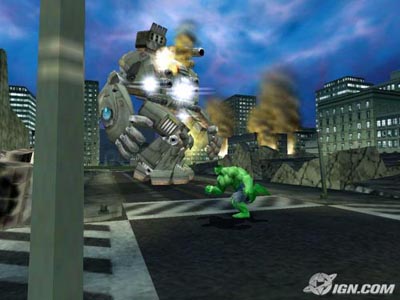
When I first heard about this new Hulk game, I was simply sitting back reading my latest issue of Nintendo Power. They had a short paragraph about it and what kind of game it would be and whatnot. I was more or less apathetic. Then I heard some more about it. Turns out the game was going to feature the same type of gameplay as Spider-Man 2. I loved Spider-Man 2! (Still unsure why I never bought it…) Maybe this game was gong to be pretty cool after all! Stories of gigantic bosses and destroying entire environments were beginning to circulate, and it didn’t take long for me to get swept up in the hype. It was going to be the holy grail of videogames, and I was going to get this game no matter what.
The months passed, and every time I saw a new tidbit of news about what they were calling The Incredible Hulk: Ultimate Destruction, I would immediately shift focus onto it and read it over twice, because I was tired of waiting for it. Fast-forward to the ninth of September. I now have the game. Unfortunately, I’m required to attend a day-long garage sale at my aunt’s house. Fark-a-doodle-doo. Fast-forward a little more to that evening. After what seemed like an eternity of waiting, I could finally harness the full power of the Hulk and bring down an entire city. Just incase you don’t want to read any further, here’s the short version: The game didn’t let me down. Normally when there’s a lot of hype and the game isn’t made by Nintendo, there’s at least a little letdown. None of that here. It’s by no means a perfect game, but all the pros more than make up for the cons.
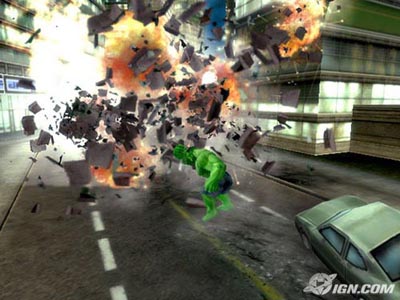
You’re going to stay for the whole thing? Well, better strap yourself in. It’s going to be a long ride, so maybe go get some chips or popcorn first. You know, something you can snack on while you sit and read. Don’t forget the soda. When you finish this sentence it’ll be too late.
It’s now too late.
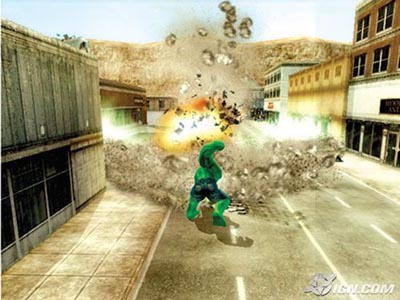
The story of Hulk: Ultimate Destruction starts well before the game starts. In fact, we jump in pretty much in the middle of a heated conflict. It seems that the Hulk’s alter ego, Dr. Bruce Banner, has been working on a device that will cure him of his affliction. That affliction, of course, is his turning into the Hulk whenever someone pisses him off. But just before he’s able to complete this magical device, his secluded cabin is ambushed by the army, which is headed by this total nutjob Emil Blonsky, who apparently has some vendetta against Banner. The Hulk manages to escape the attack, but the device is left in the rubble and zaps Blonsky good. From this come the three main objectives of the game: sort out Banner’s mental issues, collect parts for a new machine, and beat the crap out of Blonsky.
My rendition is a bit on the less-detailed side, but consider it a gesture of goodwill that I’m not going to spoil it all for you. But it’s not like it’s that great a story anyway. You’ll probably be able to guess most of the “twists” if you’ve read your share of Hulk comics. You could probably even guess who the final boss is with the information I’ve given. It’s not like the last game where the Leader just came out of nowhere at the end. Actually, I forgot to actually follow the story in the last game. I was having too much fun smashing people and stuff.
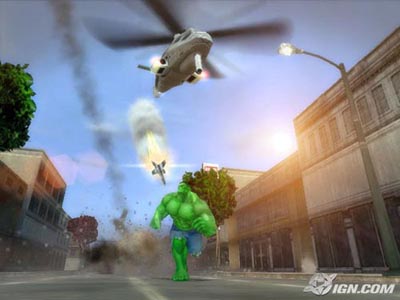
Aaanyhow, the game starts out pretty simple. With a training mission. And after that, it gets to the game, which is still pretty simple. You’re the Hulk. You can go around smashing stuff and having a grand old time, or you can try to complete missions to further the story. Sound familiar? The only real difference is that you can’t drive cars. But later on in the game, you’ll find a good enough replacement for that. The one thing that I noticed is that not all buildings are destructible. Sure, there’s the odd one every couple blocks, but I’ve wailed at buildings for well over a minute straight, and nothing but a huge series of holes. Maybe I’m missing something, or I’m doing something wrong, but I was promised fully destructible environments, not just one building here and there. That’s pretty much the only thing wrong with the game, and it could simply be caused by my idiocy.
Everything else is cool. You’re given three options of things to do when playing. I already explained that you can just run rampant through the city or you can take on the missions. So what’s the third? If the real missions aren’t your cup of tea and (God forbid) you’re bored with just causing mayhem, there are plenty of side-missions available as well. Some of them are challenges that you’d expect like races and demolition contests, but some are just plain nutty. One of my favourites puts you out in the badlands, drops a line of cars in front of you, and places a goalpost some 100 yards away. Any guesses? That’s right, a car punting challenge. There are also some other really neat challenges, like “Gamma Golf” and one where you see how far you can smack a soldier into the ocean. The issue is that you’re ranked on all the side-missions, and getting the high-scores can be really, really hard. If you don’t mind bronze, then it’s no big. But me, I’m obsessed with getting all golds. So it’s driving me crazy that they require you to be really damn good. (I’m only respectably good, for reference.)
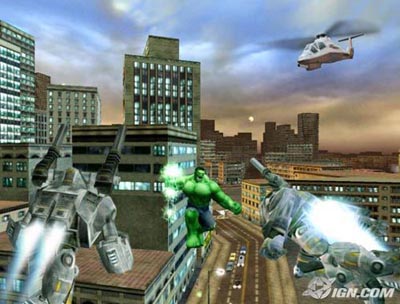
The regular missions can also be a pain in the ass every once in a while. Most of them are doable after a couple tries, but some are just downright infuriating. In most other games, I’d just give up and go home (or cry myself to sleep if I were already home), but for some reason I’ve never just given up with this game, no matter how frustrating the task. And when you pull through on one of these difficult missions, the sense of accomplishment you get is just about the greatest thing ever. Be warned though, that the hard missions aren’t necessarily saved for the end. No, some of the missions right at the beginning of the game can be pretty tricky if you haven’t yet got the hang of controlling the Hulk. Mind you, that this is also just my experience on the normal difficulty mode (Easy? Who plays easy?). I’m not touching the hard game with a ten-foot pole. At least not until I actually finish the game. To clarify, I’m stuck on the last boss. What can I say? I’m not good with time limits. If it was just a fight to the death, I’d have won weeks ago. But thus is not the case.
While I’m on the topic, the bosses in this game are, well, not exactly up to the hype. Don’t get me wrong, some are gigantic, but they’re not the bosses I’d hoped to see. Previews promised that I’d be squaring off against the Devil Hulk at one point, and that was an awesome battle (he spends a good amount of time trying to eat you), and Hulk fans should be more than aware by now that the Abomination makes an appearance, but that’s about it. Sure, there’s Mercy, but other than those three, the bosses are mostly all just big Hulkbuster robots. The last game had some real sweet boss fights against a cornucopia of villains including Madman, Ravage, Flux, the Leader and Half-life. What do we get here? A big ol’ pile of robots and only a handful of real bosses? Boring. What makes it even more insulting is that they’re all easy except for the last one. Oh well, at least it’s still fun to beat the tar out of ’em.
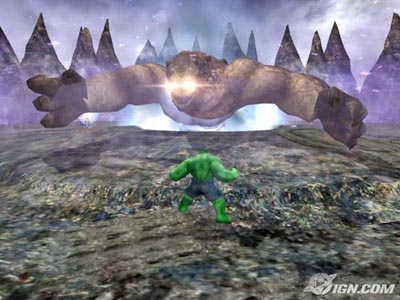
By now you’re probably wondering a little more about what it’s like to just galavant around town and bust stuff up. Well, it’s exactly that. Of course, like most games of this nature, there is a threat meter, and you will face some opposition once it gets high enough. Near the beginning of the game it’s just cops and helicopters that will take the fight to you, but as you progress further on in the story, the opposing forces will get meaner and bigger. By the very end, you’ll be hurling tanks to try to keep giant mechs off your ass if you fill that threat meter. It’s all very fun, but since the threat meter seems to have frequent mood swings and will sometimes fill very fast and other times very slowly, you might end up facing one battalion after another or try to bring out the authorities to no avail.
While you’re traipsing around town like a bulldozer on steroids, you’ll notice that you earn these things called smash points. They are used in this thing called the Buy Menu. You can trade your smash points here for things called new moves. OK, I’ll cut the crap. There are like a bajillion moves to buy in the game, and each time you complete a chapter (beat a boss) you’ll unlock another set. Some are just run-of-the-mill things like running punches or punt kicks, some are there to help you get around faster like air dashes, and some are not actually moves, but rather life meter upgrades.
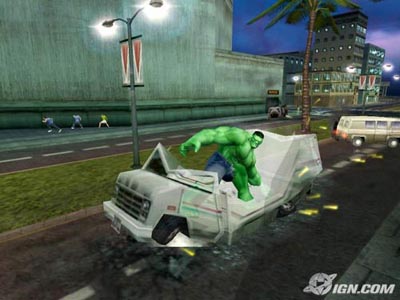
Another big category for moves are super moves. Attacks that will kill pretty much anything in a ten-yard radius of the Hulk (I may be off. I’m terrible at measurements). There is a catch though. You can only use super moves in two instances. The first is called Critical Mass. When you’re full on health and pick up a health blob, your HUD will grow a second health bar (insane!), which represents your CM energy. Getting hit will diminish it, and so will using super moves. you can upgrade it good though, and gain enough CM energy to use three supers without dropping out of CM. It’s great against weaker enemies, but you’ll rarely get the opportunity against enemies who are either really strong or in huge groups. Bosses also like to keep you just out of Critical Mass. That’s where your other option comes in, the Adrenaline Rush. Any guesses? Wrong! when your health is just about to run out, Hulk will go nuts and be able to pull off super moves, but he’ll also be one or two hits away from death. Fortunately, the Hulk’s regenerative powers will heal him up good if you can keep him from dying. To make it even better, the time Hulk needs to get out of the critical state is about the same it takes to execute a super move, so you’ve got a pretty good ace-in-the-hole.
Lastly, I have to mention the selling point for the game for me: weaponization. The Hulk can pluck pretty much anything reasonably-sized out of the scenery an wield it as a weapon. this is cool, but it gets better. After buying certain moves, you can get Hulk to mangle different objects into new types of weapons. For example, cars can be ripped in half and turned into the fearsome Steel Fists. Trucks, on the other hand, can be flattened and turned into shields that can be thrown as a boomerang, and further increasing their use, you can even learn to use these makeshift shields as a kind of urban surfboard. It’s astounding how many options they give you when it comes to offense, and being able to turn your surroundings (and enemies) into weapons is just icing on the cake.
So then, the game’s obviously pretty damned sweet as far as playing it goes, but how is it to look at? You know, there is a lot of talk about graphics being important again with the new line of consoles on the horizon, but do they really need to get any better? The Incredible Hulk: Ultimate Destruction doesn’t have the prettiest graphics that you’ve seen, but they’re way more than good enough to get the job done. The main characters (eg: Hulk, mechs, helicopters, bosses) all look great, and the environments are decent enough, but the FMV cutscenes are more or less just a step up from ReBoot. Like most FMV things, the characters seem stiff and unnatural. It’s something I’ve come to expect since it happens so often, so I don’t really care, I just thought I’d mention it. The only thing I have a problem with is that the time of day is constant. There’s normally no night/day change, it only occurs at the turn of a chapter. Again, no big, but it’s something I thought should be said.
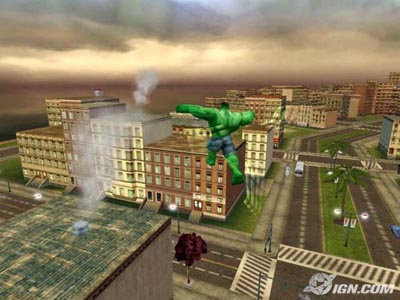
Aurally, the game does a mixed job. Sound effects are excellent. They even did a “making of” featurette exclusively for how they did some of the sound effects. It’s nothing special, but they’re all there and sound like you’d imagine they would. As far as music goes however, the game really lacks. I know there is music in the game, I just don’t remember hearing any of it. The best I can do is say that the menu theme gets annoying quick. As for any in-game music, if it was there, it was so forgettable that I didn’t even notice it in the first place. On the upside however, this is good because I can put on a CD and not feel bad about missing out on great music. It’s always a struggle for me to find a game to play when I’m listening to a CD, because music is a huge part of most games for me, and I just can’t stand to mute something like Metroid Prime or Tales of Symphonia no matter how much I might like whatever I’m listening to.
The controls for the game are pretty solid for the bajillions of moves you can pull off with them, but I do have a bit of an issue. The camera isn’t entirely friendly to the player, and while it doesn’t cause trouble so much on the “seeing things” front, it does mess up movement sometimes. It’s usually only while running up buildings on an angle that it’ll give you trouble, but sometimes it’ll just crap out on you in the heat of battle and leave you to rely on the targeting system alone.
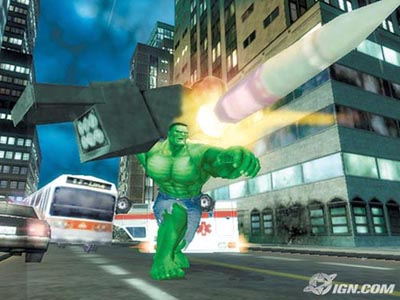
There are plenty of extra stuffed into the game if you care enough to root them all out. There are multiple “making of” movies, an in-game cinema viewer, and art galleries upon art galleries. Unlocking them requires you to hunt down big green coins hidden throughout the city and badlands. There are only 60 in all, so it’s not like it’ll take forever. Some are pretty slyly hidden inside buildings, and those are generally the only ones you can knock down. Doing this will also unlock cheats for you to enter and use at you leisure. On that note, the first cheat you get is possibly the coolest cheat ever: Hulk scores a pair of Canada shorts! After a little research, surely enough, Radical Entertainment is a Canadian company. Further research reveals that they were behind Mario’s Time Machine for the NES, and that they’re making a Scarface game.
And that pretty much wraps up everything I have to say. Obviously, I’m not going to give the game anything less than an A. It isn’t perfect, so I’m gonna hold off on the plus for now, but should I ever find a way to tear down every building in the game, rest assured I’ll come back and kick it up a notch. I’d hate to be anyone who can’t find some kind of entertainment value in this game. It’s got pretty much everything you need from adventuring to brawling to zany mini-games to treasure hunting. If you enjoy the GTA series and not Ultimate Destruction, then the only thing you enjoy about those games is the cussing and shooting, and you’re a terrible person. As I said, nobody who plays video games even casually should have trouble losing themselves in this game for hours on end. There may be more productive ways to spend your time, but I dare you to find me something productive that’s this much fun.
Note: (it’s obvious, but for the sake of good jounalism) all pics stolen from IGN.com
The Ryanland Horror
So I just watched “The Amityville Horror”. Not a great movie, but it had some disturbing imagery, so I’m satisfied. The ghosts and the basement scene towards the end gave off a really strong Silent Hill vibe, and that’s actually a movie I really want to see. I don’t like the Silent Hill games for gameplay value so much as the atmosphere and storytelling, which is different for me, because usually I don’t give two shits about the story and whatnot. With that in mind, I believe that it could make the move to the big screen faily well. But anyway, onto the main point of the post.
I’ll admit it, “scary” movies (excluding slashers) do strike some irrational fear into my heart. I don’t have any idea why, but I always have trouble with darkness and sleeping after a horror flick, no matter how cheezy/stupid/boring it is. You may think less of me for this, but that’s the way it’s always been. I’m trying to overcome it (I’m typing this in the dark), but the fear is always there. The wierd thing is, I’ve never been scared by a videogame, even if they contain essentially the same things as the movies that send chills down my spine. I mean, SH4 should scare the living daylights out of me, cause it’s filled with ghosts and horrid imagery (To be fair, there is a single room in the game that I refuse to enter, because it does creep the hell out of me), but no such fear. Even the first Silent Hill should be horrifying even though its graphical prowess is limited, but again, nothing.
I do have a sort of conclusion though. See, in the games, I’m always in control, and I’m able to defeat, overcome or escape anything that threatens me. Thusly, my brain interperets that if anything like that were to come at me, I should be able to defeat it as I did in the game, even though it may have involved some crazy voodoo magic which I don’t happen to possess. The movies however, do not put me in control, and as such I’ve never tackled those forces even indirectly. It’s always someone else doing the dirty work, and more often than not, the movie ends with the evil still intact, ready to get revenge on whoever may still be alive or plotting for its next victim. Since the antagonist is rarely vanquished in the movies, I subconsciously think that there would be no hope to escape such a menace, should it happen to be real. I know that nothing like this can actually happen, but unfortunately, that little voice in the back of my head wants to believe it could, so it ends up poisoning my entire psyche in the end. It may be hard to comprehend what I’m trying to get across, since you’re not privy to my thoughts, but I’ve explained it to the best of my ability. Hell, you’d probably go out of you mind if you had to decipher all my thoughts.
But anyway, that’s just something I needed to get out into the open. I even feel a little more comfortable now that I’ve got it off my chest. As a reward for reading this drivel, I’ll tell you a secret. The article will be up later today. I kinda slacked off today, but it’s almost done. If you didn’t read the whole spiel, then shame shame double shame on you for cheating and skipping to the last paragraph to see if there was any article news there. Also, this week’s comic is going to be hilarious. At least, that’s what we think.
The mind of a killer
Last night, I watched one of the coolest movies I’ve seen in a while: The Cell. The basic plot is that this psychotherapist (played by Jennifer Lopez) goes into the mind of a serial killer and tries to figure out where he’s got his latest victim hidden. Anyhow, I started watching because I flipped by the channel and I saw Vince Vaughn, and figured that I haven’t seen a bad movie with him in it yet so why not. A while in, it occured to me just how similar this movie is to one of my favourite PS2 games, Silent Hill 4: The Room. Honestly, if you’ve played the game and understood the whole story, you would just be blown away by when you watch The Cell and see just how many things they have in common. Or vicey versa, whatever. They’re not entirely the same, but you’d be hard pressed to not see similarities between the two. The point is, if the guys who wrote SH4 said they weren’t at all influenced by this movie, I wouldn’t believe them for a second. My advice is to play SH4 and watch The Cell. Awesome game, awesome movie. It’s just like how the original Silent Hill had a lot in common with Jacob’s Ladder (which are also awesome, by the way). That is all.
The new lab tech
1. I fixed some links on the sidebar there. By that, I mean, struck out a dead one, and accomodated to a changed domain name. Changes were only applied to the main page.
2. After waiting three long weeks, Jump Superstars finally arrived yesterday. I love the game, and have a hard time saying where it would rank in my current library. It’s entirely in Japanese, but I’m coping pretty well. I’ve alrady reviewed the demo, so I don’t know about an article…
3. Coozy for Hire’s second comic is up. It’s now official that new comics come out on Thursdays, and that my (comic Ryan’s) storyline will be hoggin’ the spotlight for the next three comics or so. Thus is what happens when you put me in charge of actually managing the comics.
4. Disturbed’s new CD Ten Thousand Fists is out now, and I’m picking it up today. HIM’s Dark Light is due on the 27th, as well as Corner Gas season 2. Whoopee!
Final Fantasy 7: Advent Children
Ok, before I start this up, if you’re a Final Fantasy 7 fanboy/girl, and refuse to believe that anything relating to the game can be wrong, just stop reading now. If you hate FF7 and are looking for a good bashing of the movie, stop reading now. Finally, if you don’t want spoilers, stop reading for the love of Odin. This review goes over pretty much every little nuance of the story (as weak as it is), so it’s absolutely loaded with spoilers. Anyone else may continue. And if you’re a hot chick, you may E-mail me some naked pictures of yourself.
As the title may have lead you to believe, I’ve now seen the Final Fantasy 7: Advent Children movie. What I have to say about it is pretty much irrelevant to how I feel about it, and the technical stuff here is more or less for me to nitpick and tell anyone who wants to see the movie (and doesn’t mind spoilers) what to expect. So let’s get the show on the road already.
The first thing I’m going to go over is the story. That shouldn’t take very long, since it’s the most bare-bones plot I’ve seen since Super Mario Bros (the game, not the movie). It starts off summing up what happened in FF7, and then goes on to tell you how people have become poisoned or whatnot by some mysterious force. Not long after, we learn that these people (all children, by the way) are sick because they have Jenova’s DNA or whatnot and the world doesn’t like them for it. Then these three dudes appear (with Jenova DNA of their own), bearing a resemblance to Mr. Oh-so-cool himself, Sephiroth. Turns out they’re looking for the remains of Jenova so that they can have a reunion of some kind. Blah blah blah. Cloud and company enter, cloud fights bad guys, Turks appear, say they want to help restore the world, secretly hold remains of Jenova. So stuff goes on, fight scenes happen, and the bad dudes take all the infected kids to a pool, brainwash them, and then attack the city. Leader of bad guys (forgot his name, not looking it up) summons goofy-looking Bahamut, kids become un-brainwashed, Cloud & friends defeat Bahamut. Rufus (Turk leader) reveals Jenova remains, bad guy leader gets them, Cloud chops them, bad guy cries, fight scene, bad guy turns into Sephiroth (Ooh! What a surprise!), more fight scene, Cloud wins, gets shot, come back to life, lame ending.
And that’s it. I should mention that the entire plot is completely obvious after the first ten minutes or so of the movie, so it’s not like you’re going to be surprised at all even if you didn’t read the summary. I mean, nothing at all happened, with the exception of Bahamut, that I didn’t see coming from a mile away. The tale was interesting to watch, but it was more predictable than a clock. But whatever, I’ve never been to worried about how good a plot is anyway. Unless of course, I’m reading a book.
Now while the plot is passable, there are a few things I have to pick out. For one, the brainwashing of the children was totally irrelevant. They did nothing but stand around mindlessly while they were brainwashed, and as far as I remember, the bad dudes never even mentioned using them for anything. But I digress, there are some bigger issues abound. Like Rufus, for example. When he first appears, he’s in a wheelchair, all cloaked as if he’s horribly scarred or whatnot. Later on, he hops off the wheelchair and throws off the cloak, revealing that he looks just as normal as ever. But he’s still got an eye-patch. Any guesses? Yep, it too gets thrown off, and under it is a perfectly good eye! Why? Why? There was no logic behind pretending to be crippled and deformed. Maybe he just wanted to fool everyone. But there was no real reason presented.
And the biggest issue I have with the movie is the entire Bahamut scene. Firstly, the leader of the bad guys takes the Bahamut materia and absorbs it into himself. The game had us believe that materia was clipped onto your armor/weapon or whatnot, and not that you’d absorb the damn thing and create a neon tumor. Then when the big dragon appears, he looks like a total homo, with stupid-looking armor and terribly designed wings. I swear, this incarnation of the King of Dragons does almost as much injustice to him as his FFX representation. And then to top it all off, the good guys start attacking it! Why would you attack a goddamned summon monster? Theoretically, they should just be able to summon it again. but that’s not even the worst of it all. Near the end, Bahamut flies way, way up to the top of a tower, and Cloud has to follow him somehow. Let’s see, what’s the best way to do this? Well the idiots that made this movie decided that each character from the FF7 game should fly in and throw him up a bit more. It’s impossible to describe this pile of shit scene with words, so I drew a diagram. and then, finally, Cloud actually manages to carve this gigantic beast – the most revered summon of like ever – right in two. Stupid, stupid, stupid. And Cloud wasn’t even using any materias. At least, I didn’t see any tumors of colour on him.
That’s pretty much all I found unacceptable there though. Otherwise, it’s only extremely nitpicky, like physically impossible fighting maneuvers and hair that was never meant ot look realistic. And to be fair, it’s time I said what was good about the movie.
Firstly, and most obviously once you’ve seen their first couple scenes, Reno and Rude make great comedy relief. Nearly every scene they’re found in is hilarious or at least will make you smile a little. then there’s the fact that Reno can crawl up walls like Spider-Man, which I found extremely entertaining, especially when Rude tried to climb up with him on one occasion and promptly fell flat on his back. they’re easily the best characters in the movie. I was never too big on any characters from FF7 (with the exceptions of Vincent and Barret), but if these guys played a role in the game at all similar to the one they had in the movie, I can’t believe that I missed it. Another thing that was awesome is Barret’s gun arm. In the flashback at the beginning, the gun was tiny and I made an angry note of that right away, but when he popped in later on, it was huge and shot like fifty bullets at a time. After rereading it, that sentence sounds unnecessarily phallic.
There were some other really cool things going on in the movie, like Cloud’s bike. the sides of the thing fan out, and reveal a rack of swords for him to choose from. And by the end, he’s used and lost all of them. The fight scenes were pretty fun, except for the fact that a few maneuvers that various characters pulled off were just plain impossible. And I’m not talking run-up-a-wall impossible here. I can accept a lot of over-the-top stuff, but they crossed a couple lines here. Other than that, though, lots of swordfighting and a cool fistfight with Tifa and one of the bad guys.
I’m sure there was a lot else that I both liked and disliked about the flick, but I can’t think of ’em at the moment, so I’m gonna wrap this baby up. Like I said before, everything I mentioned was for the sake of the review. None of it really impacts my final judgement. All things good and bad aside, I will say that this movie was a success on the grounds that I was entertained. That’s really all it takes for me to give something a good review these days. As long as I find a movie/game/song/what-have-you entertaining, chances are that I’m gonna end up giving it a positive rating. So the FF7 movie, although a lot of things about it made me angry, gets a solid A-. Somewhere between 85 and 90 on the percent scale. If I’d seen it in a theater, I wouldn’t ask for my $10 back. I would watch it again, but I surely wouldn’t buy it. It was much better than I’d anticipated (I expected very little. Video game movies are always the suck), but it wasn’t perfect. I’ll recommend it, just don’t tell me that it’s the best movie ever (not even in the top 50). I know it’ll be way overrated, because the game was, and those sheep that are Square fans (I personally like Enix a lot) will fall in love with anything that has Cloud or Sephiroth on it. Example: Ehrgeiz. That was one of the worst fighting games I’ve ever had the misery of playing, yet many loved it for its FF7 tie-ins. But now I’m way off-topic. Final Fantasy 7: Advent Children is worth your time. Go watch it. Just don’t ask me to talk about it any more.
| The Good Stuff: |
|---|
|
| The Bad Stuff: |
|---|
|
WTFWTFWTFWTFWTF….
Words fail me. Serously, I’m not gonna touch this one with a ten-foot pole (I’ll use it, but I’m not going to get into what I think of it). Details.
It’s coming right for us!
Just some minor changes to the ol’ site today. Fixed up the banner so it’s less than half the size it originally was. If you check it out, it still says GIF, but I assure you, it’s a PNG dressed up as a GIF so that I didn’t have to change each and every page from GIF to PNG. That would have been tee-dee-ous. I also went over the second Art Gallery, and fixed it up so that all the bandwidth-devouring BMP file have been converted into more friendly PNG files. On another note, Audioscrobbler has been renamed to Last.FM, so I got that changed up (on the main page only).
In other news, I posted my bio on the BBS for one of my classes, so if anyone visits that, they’ll probably click the link I provided for the site. So I might have a spike in hits. Just thought I’d mention it. And while I’m on the subject, university is pretty cool, just (as dumb as it sounds) too many people. I can’t find anywhere nice and secluded to read/draw/video games/what-have-you. Then again, I haven’t explored the entire campus, so there is still hope. A hope that’s too far away from my classes to be worthwile, but hope no less.
I’ve been working on a new pseudo-article, and it’s such a thing that it might get updated every so often, unlike the current offerings, which have become pretty much stagnant. Be ready for that around the end of the month.
Finally, I got The Incredible Hulk: Ultimate Destruction (you may have heard me rant about how cool it was going to be), and I love it to pieces. It’s similar to GTA(X), but doesn’t get boring after an hour. Expect articleization sometime in the near future.
Oh, and Coozy For Hire should be getting off the ground any day now. Stay tuned for more.
Moooooo…. Braaaaainsss…..
Ha ha! I am not dead! Just got a little delayed due to some unexpected time constraints. Anyway, I just got back from the cottage, which is a perfectly good excuse for the lateness of this here posty.
Now as I was saying. Destroy All Humans. A decent game to say the least. While I had originally preceived it as an extraterrestrial version of Grand Theft Auto, I was somewhat surprised to find that it’s not entirely the same. First of all, it’s obviously a different context, and killing is a lot more fun when you’re an alien with psychokinetic powers and a vast array of alien weapons to put the hurt on them with. The game itself is set way back in the fifty-somethings, and as far as TV has taught me, is pretty much faithful to the era. People are hicks, Elvis is still relatively unknown, and communism is the number one cause of everything bad. The story is a pretty nifty one. You’re this Furon alien dude, Crypto, and your species has a bit of a problem. See, they’ve relied on cloning to propogate the species for so long, and now their DNA is going stale and they’re getting dumber by the generation. So your task is to visit Earth and enslave the human populace to steal their precious DNA, because it contains a little Furon DNA for ages ago when the Furons landed on Earth and did a little mating. A bit messed, but it’s great as far as alien attack stories go.
The game’s idea is similar to that of the GTA, but you’re confined to levels, rather than a huge city to explore. Fear not though, you crazy GTA fanatics, as the levels are pretty huge and will each take at least half an hour to fully explore. Also, your missions are handed out to you on the mothership, instead of finding them among the various levels. But other than that, you’re pretty much free to roam to your heart’s content and cause as much havoc as you desire. You can’t steal cars or anything, but you do get to pilot a flying saucer, and that almost more than makes up for the lack of driving. Obviously, you’ll be spending most of your time on foot, and the game gives you several great ways to torture the humans. Crypto is equipped with four main weapons: the Zap-O-Matic (obvious), the Desintegrator Ray (obvious), the Ion Detonator (think remote mines), and best of all, the Anal Probe. All have their charms, and all are a bunch of fun to play around with. But the best weapon against the humans is easily PK. Crypto can pick up pretty much anything (once the required upgrades are purchased) and swing it around, bash stuff with it, or just huck it at people. You’ll have a lot of fun probing and ionizing humans, but the real good stuff lies in simply flinging them around like dolls.
There are some sweet unlockables in the game too. While one set of said extras are unlocked by scouring the maps for alien probes (think hidden packages), others are opened to you by simply playing through the game. Most of them are promotional movies or artwork, but there are two videos that really stand out from the rest. First off: Plan 9 From Outer Space. Sadly, they only included the first 15 minutes or so (haven’t actually seen the whole movie) and it could have been absolutely amazing, but is only a little amazing because it’s only an extended clip. The film is notorious among pretty much everyone who likes a good cheese flick, and is commonly referred to as the worst movie ever made. From what I saw though, I’m sure the rest would have been hilarious. Anyhow, the second sweet video almost makes up for the skimping on Plan 9. Ever heard of “Teenagers From Outer Space?” Neither had I, but all two-and-something hours of it are there to be watched, should you complete the game. It’s a horrible movie, and I loved it. I’d rent DAH again just so that I could take screencaps and review it. And you should find some way to watch it, and Plan 9 as well.
To sum it all up, Destroy All Humans is a great game. It’s fun to just screw around and wreak havoc on Earth, and doesn’t get boring after half an hour like the GTA games. Some of the missions are actually pretty tough, and hunting for the probes will probably take you forever without the aid of a map. Production values are great (the dude who voiced Zim does one of the main characters) and the fact that it contains an entire movie is certainly a plus. It’s a rental for sure. If you like it, pick it up. Hell, I’d consider buying it just for Teenagers From Outer Space. Man I want to watch that movie again.
Stealthy like that
Don’t know if ya noticed, but a new article snuck onto the articles page sometime yesterday. Yes, that’s right. Tomorrow, I shall ponder the true value of one “Destroy All Humans” video game. But only in blog form. It does lend itself to a bigger, more monumental project, but I have plans tonight and it has to go back today. I’d get my screenshots done now, but I’d rather sleep. Should have been down a couple hours ago, as far as I see it. But I’m rambling, so I’ll call it a night. ‘Morrow, puny Earthlings.
